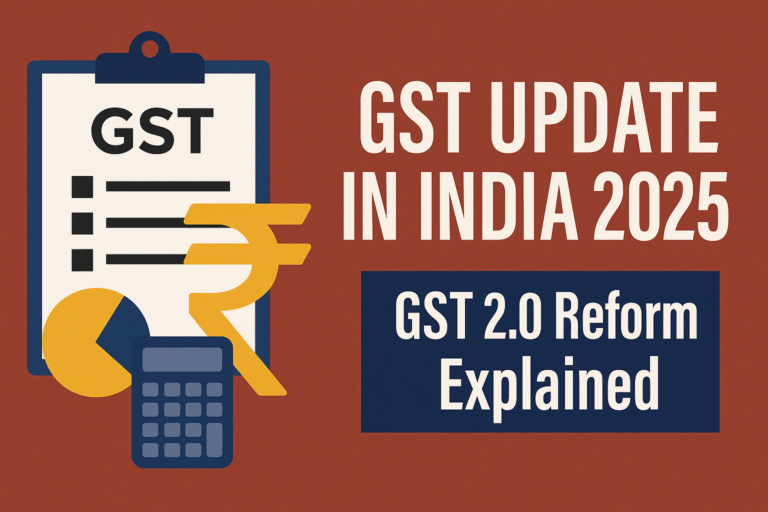Table of Contents
Introduction: Why GST Update 2025 Matters
The Goods and Services Tax (GST), introduced in 2017, marked a historic shift in India’s taxation system. Now, in September 2025, the government has rolled out GST 2.0, the biggest reform since GST’s inception. With fewer slabs, lower tax on essentials, and higher levies on luxury and sin goods, this update is expected to boost consumption, simplify compliance, and support India’s economic growth.
Key Highlights of GST Update 2025
1. Simplified Tax Structure
- GST slabs reduced from 4 to 2 major slabs.
- 5% (merit rate) and 18% (standard rate) for most goods and services.
- 40% (luxury & sin rate) for high-end items and harmful products.
- Certain essentials brought under zero GST.
This makes the system easier for businesses and consumers while reducing classification disputes.
2. What Gets Cheaper After GST 2.0
- Zero GST: UHT milk, paneer, chapati, paratha, certain cancer drugs.
- 5% GST: Soaps, shampoos, toothpaste, hair oils, bicycles, tableware, medical oxygen kits.
- 18% GST: TVs, ACs, dishwashers, cement, small cars, motorcycles below 350cc, trucks, buses.
- Electric Vehicles (EVs): continue to attract just 5% GST, boosting green mobility.
👉 Prices of consumer durables like ACs, TVs, and dishwashers may drop by 8–9%, benefiting middle-class families.
3. Items Under 40% GST (Luxury & Sin Goods)
- Cigarettes, gutkha, pan masala, carbonated drinks.
- Luxury bikes above 350cc, yachts, helicopters, private jets.
- IPL & big entertainment event tickets (up from 28% to 40%).
This move aims to discourage non-essential spending while ensuring higher revenue.
4. Impact on Indian Economy
- GDP Growth Boost: Economists expect a 1–1.2% rise in GDP growth over the next 4–6 quarters.
- FMCG & Consumer Goods: Companies like Hindustan Unilever, Nestlé, LG, Sony, Maruti, Toyota to benefit.
- Stock Market Impact: Indian equities surged after the announcement, with strong gains in FMCG, auto, and appliance sectors.
- Ease for MSMEs: Less confusion on slabs, faster refunds, and simplified compliance expected.
GST Update 2025: Benefits for Consumers
- Cheaper everyday essentials → relief for middle-class households.
- Affordable consumer durables → festive season shopping gets a boost.
- Clear tax structure → fewer disputes at billing counters.
GST Update 2025: Benefits for Businesses
- Reduced compliance burden with fewer slabs.
- Better cash flow due to quicker refunds.
- Boost for startups & MSMEs as slab confusion reduces.
- Sectoral push for FMCG, autos, and electronics.
FAQs on GST Update in India 2025
Q1. When will the new GST rates come into effect?
👉 The revised rates will be applicable from September 22, 2025, just before Navratri.
Q2. Which items are tax-free now under GST 2.0?
👉 UHT milk, paneer, chapati, paratha, and life-saving cancer medicines are exempt from GST.
Q3. What is the highest GST rate in India now?
👉 The new 40% GST slab applies to sin and luxury goods like cigarettes, pan masala, luxury bikes, and IPL tickets.
Q4. Will electric vehicles become cheaper?
👉 Yes, EVs continue to attract only 5% GST, making them more affordable compared to petrol/diesel vehicles.
Conclusion
The GST 2.0 update in India is a landmark reform that simplifies taxation, reduces the burden on essential goods, and boosts India’s growth story. By making daily-use items cheaper and luxury goods more expensive, the government has struck a balance between public welfare and revenue generation. As the festive season approaches, consumers and businesses alike are set to benefit from this major GST overhaul.

